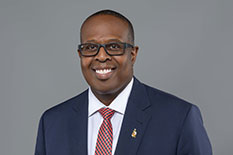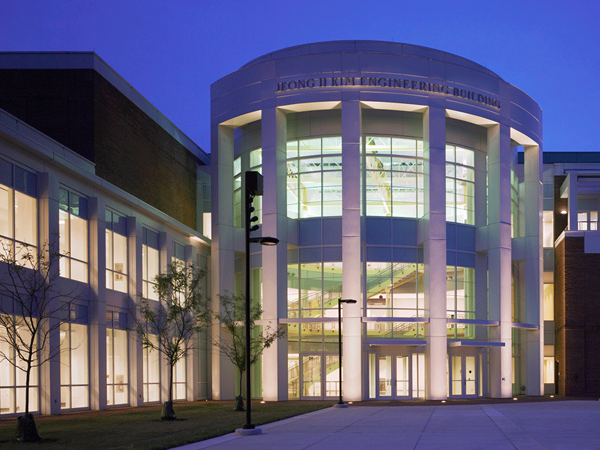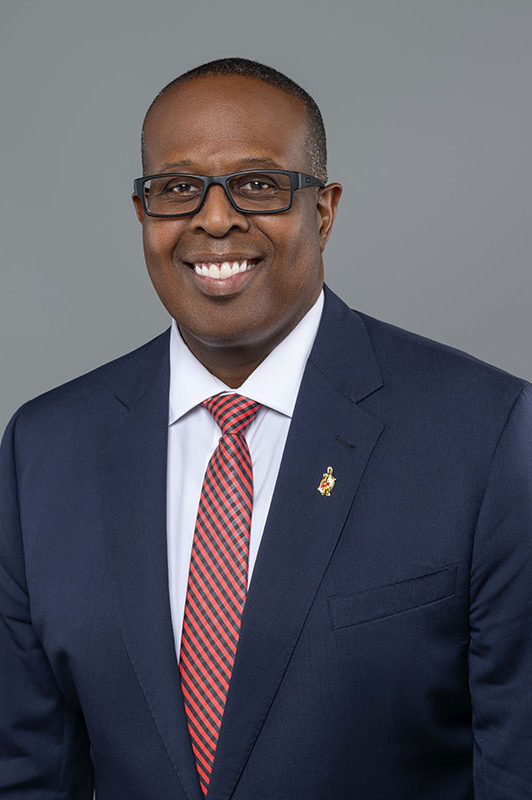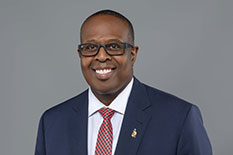News Story
The Clark School Celebrates the Legacy and Impact of Black Engineers
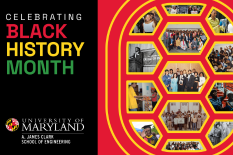
At the A. James Clark School of Engineering, we continually honor the contributions of Black engineering trailblazers, whose accomplishments improve our society through innovation and leadership in our field. Join us this February as we celebrate Black History Month and highlight these inspiring Terp engineers:
Read Dean Graham’s Black History Month message
Each year, the university’s Office of Multicultural Involvement and Community Advocacy (MICA) coordinates a calendar of events to commemorate national Black History Month. This year's campus-wide theme, “Black Legacies and Horizons,” invites us to explore many contributions—past, present, and future—of Black Americans to our campus and country.

With a love for science, conservation, and her fellow humans, finding a major that fit just right took some time—but Kelsey Afoakwa always thought she would attend UMD. While she was a student at Eleanor Roosevelt High School, she took part in the Maryland Ascent Program for first-generation college students and participated in the ESTEEM/SER-Quest Research Mentoring Program sponsored by the Center for Minorities in Science and Engineering. Through a high school internship program, she conducted research at the Environmental Aerosol Research Lab led by Professor Akua Asa-Awuku in the Department of Chemical and Biomolecular Engineering. “Being on campus while still in high school was a big deal,” Afoakwa says. “I felt responsible, because I was being trusted to do research independently.”
Now as a junior bioengineering major, the Banneker Key Scholar is taking every opportunity to conduct research at the intersection of engineering and society. Working in the lab of Bioengineering Assistant Professor Erika Moore, Afoakwa is studying uterine fibroids, the most common yet understudied tumor in women. For an Engineering World Health project, she helped design and make prototypes in Terrapin Works’ Keystone Woodshop for a storage device to protect gas cylinders in hospitals located in earthquake-prone areas. Over the winter term, Afoakwa traveled to Costa Rica for a short-term study abroad program focused on sustainability and renewable energy systems. “It’s very important to my Maryland experience to apply what I’m learning in class to real-world examples,” she says.
The daughter of Ghanaian immigrants, Afoakwa was taught a strong sense of respect for herself and others. Intent on paying forward her opportunities and making the Clark School a more welcoming place, Afoakwa is a ClarkLEADER and sits on the board for the LSAMP STEM community. “It’s important to show incoming students that there is a minority presence here,” she says. “You can find your tribe.”

With a love of science, Austin Appiah came to UMD the summer before his first semester for the LSAMP Bridge Program for Scientists and Engineers. Housed at the Center for Minorities in Science and Engineering (CMSE), the program connected him with peers and mentors, including Wright Makambi ’19, Ph.D. ’24, who has since earned his doctorate in chemical and biomolecular engineering. Now a chemical and biomolecular engineering sophomore, Appiah is paying forward his opportunities as a bridge mentor, helping teach General Chemistry for Engineers and Calculus to first-year students. Born to Ghanaian parents, Appiah is one of the few Black students in the Design Cultures & Creativity living-learning program. “It helps,” he says, “to see someone like Makambi, someone who looks like me, excelling in chemical engineering.”
At the Clark School, Appiah is especially proud of making it through Thermodynamics, taking home the People’s Choice Award at the 13th Annual Alumni Cup Competition, and conducting research as part of the LSAMP Undergraduate Research Program. Appiah’s work in the Complex Fluids and Nanomaterials Group under Professor and Patrick and Marguerite Sung Chair Srinivasa Raghavan focuses on the development of multi-compartment capsules to trigger luminescence on demand. Such research seeks to develop new ways to achieve responses that mimic those in biology.
Outside of the classroom and lab, Appiah is involved with the Black Engineers Society at UMD, the National Society of Black Engineers, the UMD Barbell Club, UMD intramural soccer (he plays goalie), and UMD Baptist Collegiate Ministries. He is currently an engineering intern with ExxonMobil in Baton Rouge, Louisiana. “I am excited for all the opportunities ahead,” he says.

A Prince George’s County native and double Terp alum, Bruk Berhane ’03 (electrical engineering), Ph.D. ’16 (minority and urban education) is excited about where the engineering education field is headed. Berhane worked as an electrical engineer, a researcher, and a high school math teacher before returning to UMD to pursue a doctorate that would fuel his passion for the people in people-centered engineering.
Berhane served as a program coordinator for the Center for Minorities in Science and Engineering and became director of undergraduate recruitment at the Clark School. His research and leadership on Engineering for US All (e4usa) and other initiatives increased access and interest in engineering among students from different backgrounds, helping to shape the future of engineering at the Clark School and beyond. Berhane’s path from staff to faculty member at UMD was a winding one. He says his mentors, including Professor Emeritus and former Associate Dean of Engineering William “Bill” Fourney, Undergraduate Student Affairs Program Director for the Clark School Nicole Roop, and University President and Glenn L. Martin Professor of Aerospace Engineering Darryll J. Pines, made all the difference. “Nontraditional paths are viable and doable with great mentors,” Berhane says.
Today Berhane serves as an assistant professor of engineering education at Florida International University (FIU), where he runs the ABET-accredited Interdisciplinary Engineering undergraduate degree program, which focuses on human-centered engineering design. A Hispanic-serving institution, FIU’s student demographic is also what Berhane calls “post-traditional,” with 40 to 50 percent of students coming from community college and adding “maturity, life experience, and value” to the university. “This population makes me think differently about the engineering ‘pipeline,’” he says, preferring the term ‘pathways.’ “Let’s talk about ‘pathways,’ which recognize the many different ways people get to engineering degrees.”

For Jay Easter, his first introduction to STEM was reading everything he could get his hands on about astrophysics, particle physics, and quantum physics—topics that made the quiet elementary school student feel less small. He credits his mom, an elementary science teacher, for helping him find solace in science. Fast forward to middle and high school, and Easter wanted to do something actionable, landing on engineering. At the University of Maryland Eastern Shore (UMES), he specialized in mechanical engineering; within his first month on campus, he began research as part of UMES’s LSAMP Undergraduate Research Program (URP), studying microfluidics, and enjoying professional development opportunities, including meeting with UMD professors.
Today, the second-year Ph.D. student in the Department of Materials Science and Engineering at College Park is a Dean’s Fellow in the lab of Distinguished University Professor and Maryland Energy Innovation Institute Director Eric Wachsman, working on solid-state battery separators for better performance, crucial for vehicle electrification and sustainability. Easter’s biggest accomplishment so far? Changing how he approaches problem-solving, from the top-down approach of the mechanical engineer to the bottom-up approach of the materials scientist.
Very few things about graduate school have been easy, he says. Easter credits his family—he has a twin sister, who also graduated from UMES—and his faith in Jesus Christ for his will to persevere. As for advice for students considering graduate school, Easter says to reach out to students in the lab to get a feel for the lab climate and culture. “To everyone in the department who took a chance on me, so I could be in the place I am right now,” he says, “this is me saying thank you.”

Before she knew what she wanted to study in college, Symone Jenson had committed to UMD. A student athlete, Jenson juggles two “separate worlds” as a junior fire protection engineering (FPE) major and a midfielder for the women’s soccer team. Soccer season can be a lot, she says, traveling for the Big 10 from Wednesday through Sunday, but she credits her teammates, classmates, and academic adviser, Associate Director for Undergraduate and Graduate Programs Nicole Hollywood, for helping her achieve a balanced and positive campus experience. “I’m really happy that soccer and my major lined up,” she says. “All my cards worked out perfectly.”
Jenson developed a strong interest in engineering through her high school’s STEM curriculum. Her interest in FPE was piqued when she took a summer internship, helping to install sprinkler systems, a process she found fascinating. The summer after her first year at UMD, she worked at Johnson Controls, where she learned more about system design. “It was very cool,” she says, “seeing how a design they created helped save things and people from fire.”
In addition to her athletic and academic pursuits, Jenson has been involved with the UMD student chapter of the Society of Fire Protection Engineers and served as a team representative for UMD’s Student-Athlete Advisory Council. Jenson’s proudest accomplishments so far include developing a passion to one day become a sprinkler contractor and business owner and forging strong personal and professional relationships. “These things are going to set me up for the rest of my life,” she says.

Clark Scholar Toni Paylor was inspired by her great-grandmother—Ida Van Smith, an African American pilot and flight instructor who loved introducing children to aeronautics—to study aerospace engineering at the Clark School. Having focused on criminal justice at North Point High School, Paylor enrolled in the preparatory LSAMP Bridge Program for Scientists and Engineers the summer before her first semester and was introduced to the Center for Minorities in Science and Engineering (CMSE). “Clark Scholars and CMSE set me up 110 percent,” says the sophomore. “They’ve provided resources, fellowship, and a sense of community I wouldn’t have found otherwise.”
Coming to UMD without technical engineering experience, Paylor studied wiring and coding in different languages on her own time. She credits Clark School professors, especially Mary Bowden (who also directs the Maryland Nearspace Balloon Payload Program), for offering her every opportunity to learn something new. In addition to challenging coursework, Paylor conducted research as part of CMSE’s LSAMP Undergraduate Research Program, working in the Composites Research Laboratory under its director, Minta Martin Professor of Aerospace Engineering Norman M. Wereley. She will present the results of her 3D printed composite material—a kind that could be used for protection in airplanes, cars, and football helmets—at the 2025 USM LSAMP Research Symposium on February 15.
Paylor says she hasn’t yet met another Black woman in her aerospace engineering classes. She acknowledges her family—Paylor’s mom is a UMD employee—for giving her the confidence to pursue the major and take on leadership roles. In addition to being a member of the Black Engineers Society, Paylor restarted the UMD section of the National Council of Negro Women and serves as its president. “I want to build a community for people on campus who don’t have the clubs and organizations,” she says.

With a Ph.D. from the University of Georgia, Darren Pierre M.A. ’06 (higher education policy and leadership) is an educator focused on college student and leadership development. As a senior lecturer in the Clark School Office of Global Leadership, he oversees the Global Engineering Minor, where he teaches that leadership is a process that is available to all. “I love to be in a space of learning, where students can explore and experiment, and where we can interrogate together leadership theory,” he says. “I see a classroom as a simulation for what we do in life.”
Growing up in a single-parent, working-class household, Pierre became a first-generation college student actively involved in campus life. With a “kinship” to the act of leadership, Pierre took the advice of a mentor who suggested he think about pursuing an advanced degree in higher education and student affairs. He sees his work as complementary to the engineering disciplines, with positive impact evidenced by the alums who return to speak to his students about their leadership experiences in industry. He credits Sharon Fries-Britt, a Distinguished University Professor in UMD’s College of Education, for inspiring his approach. “She holistically celebrates what it means to be a faculty member, in terms of brilliance of scholarship, significant dedication to service of the institution, and a profound and admirable dedication to students,” he says.
In addition to his work in the classroom, Pierre serves as a member of the Engineering Senate, represents the Clark School as director of scholarly activities for the American Society for Engineering Education’s Engineering Leadership Development Division, and helped host the International Leadership Association’s 2024 Leadership Education Academy. He says the ADVANCE Program for inclusive excellence at UMD has been a remarkable resource for community and professional development. A relationship expert, motivational speaker, and author, Pierre’s second book releases later this year.

Tamoy Seabourne’s interest in environmental energy was piqued at a conference in 2017, where he heard the prime minister of Barbados describe the effects of climate change as especially harmful for countries closest to the equator. Thereafter Seabourne aimed to create sustainable ways of using or supplying energy for places in the Caribbean, including his native Jamaica, which is rich in sun and wind but imports fossil fuels at great economic and environmental cost. After completing his bachelor’s in mechanical engineering with a concentration in environmental science from Rochester University, Seabourne joined the UMD Center for Environmental Energy Engineering (CEEE) in 2023 as a Ph.D. student in mechanical engineering: “In my trying to fuse environmental policy with engineering, UMD—with its proximity to the EPA and other agencies—stood out to me.”
At CEEE, Seabourne’s research focuses on designing environmentally friendly, energy-efficient heat pumps. He co-authored a paper published last year in which his research team made the case for developing heat pump technologies geared toward the wood-drying industry. “The wood drying process [used to prepare lumber for construction and furniture] is very carbon intensive,” Seabourne explains. “With the big push for net zero carbon emissions, we’re trying to electrify the drying process and make it more efficient and marketable, so it becomes the new global standard.”
In addition to his work in the lab, Seabourne pays forward his opportunities as an instructor in the Caribbean Summer Scholars Program for Caribbean high school students. At UMD, he is involved with the Mechanical and Reliability Engineering Graduate Student Association, the Black Graduate Student Union, and intramural soccer.

Resilience is key for civil and environmental engineering (CEE) alum Erin Stewartson ’20, in more ways than one. The daughter of Jamaican immigrants impacted by a hurricane, Stewartson developed a deep-seated interest in using resilient design to help people. Initially drawn to architecture, she came to identify as more of a “materials girl,” interested in the intersection of chemistry and engineering. As a high school student, she participated in UMD’s ESTEEM/ SER-Quest summer program through the Center for Minorities in Science and Engineering (CMSE), where she was introduced to materials science. As a CEE major, she gained formal and informal research experience through her participation in UMD’s LSAMP Undergraduate Research Program (URP), studying how compost affects soil strength in highway slopes, and through her involvement with the American Concrete Institute and UMD’s Concrete Canoe team. Internships with Turner Construction Company further cemented her interest in resilient materials.
Stewartson credits her participation in URP with helping her land a fellowship from the National GEM Consortium to pursue a doctoral degree in civil engineering from the Ohio State University. Today she researches cement chemistry, focusing on supplementary cementitious materials to decrease the amount of carbon released during concrete production—crucial for an industry that aims to be carbon neutral by 2050. Moving back to the Washington, D.C., area in 2022, she continues her research as an intern at Turner-Fairbank Highway Research Center and plans to manage her own lab after graduation. “I really like being at the cross-section of academia and research, conducting the science behind innovation,” she says.
She feels blessed to have grown up in the area, “where Blackness is celebrated,” and to have had a UMD experience where she could share her culture and learn about others. She was a member of UMD’s Adventist Student Fellowship and sang with the Maryland Gospel Choir—and, with performer Tiffany Blossom, was the first student to sing “Lift Every Voice and Sing (the Black national anthem) at a UMD basketball game. A believer in Jesus Christ, Stewartson says she is “always singing for Jesus,” even in the lab, where her lab mates call her “the singing engineer.”
Meet more members of our community.
Published February 3, 2025
